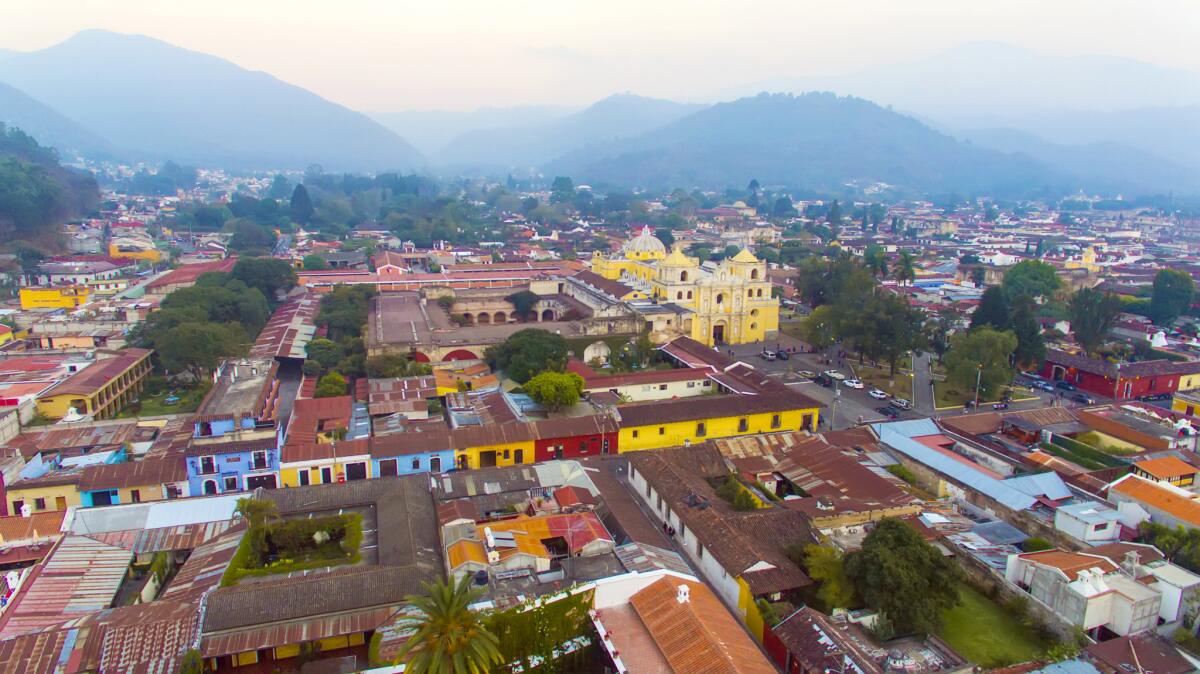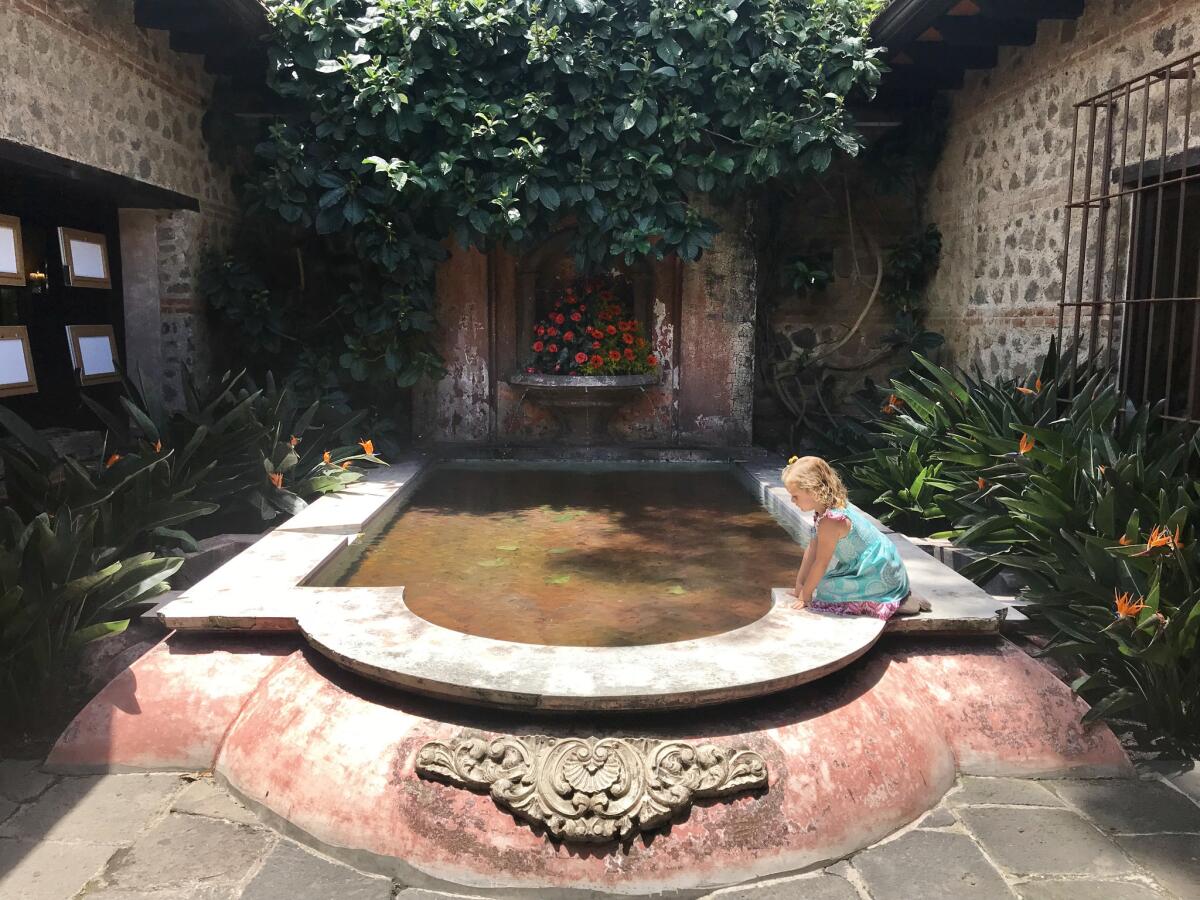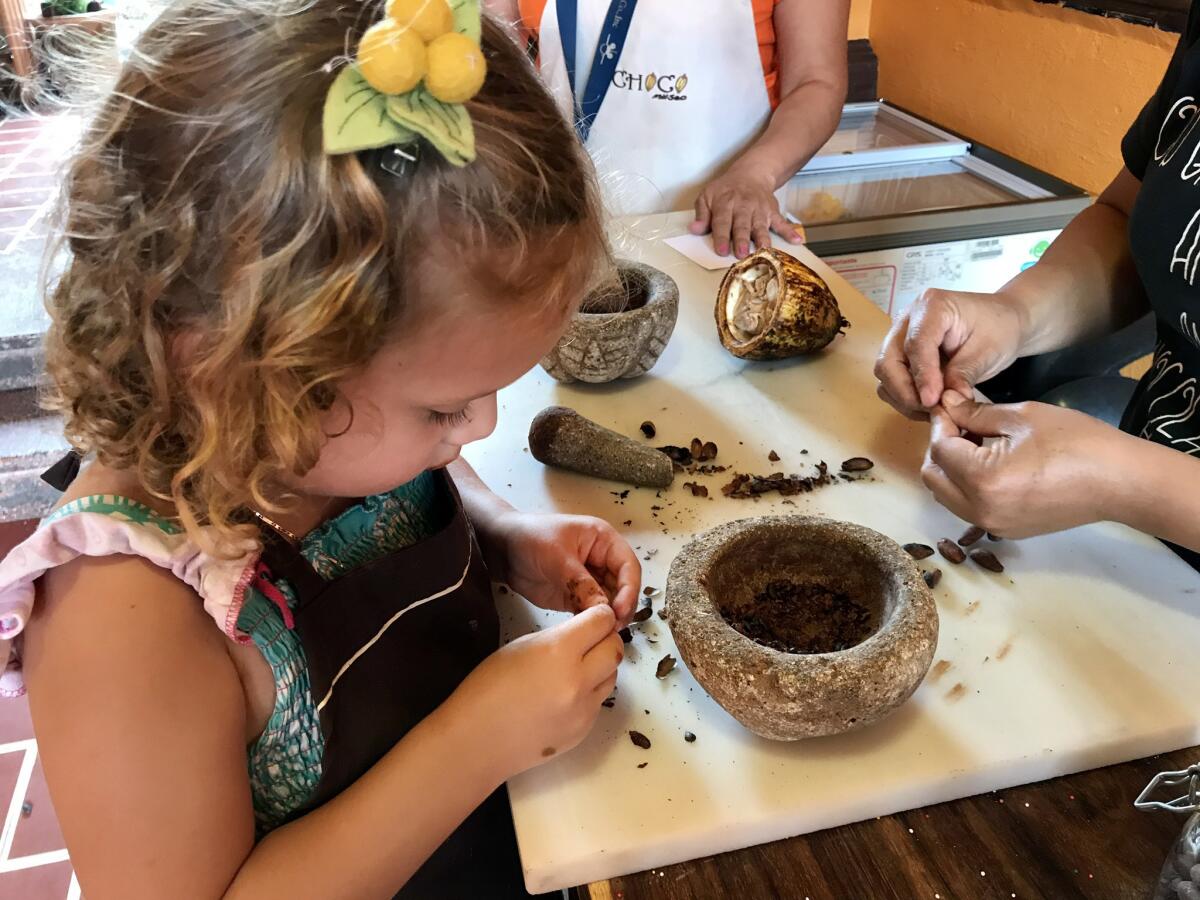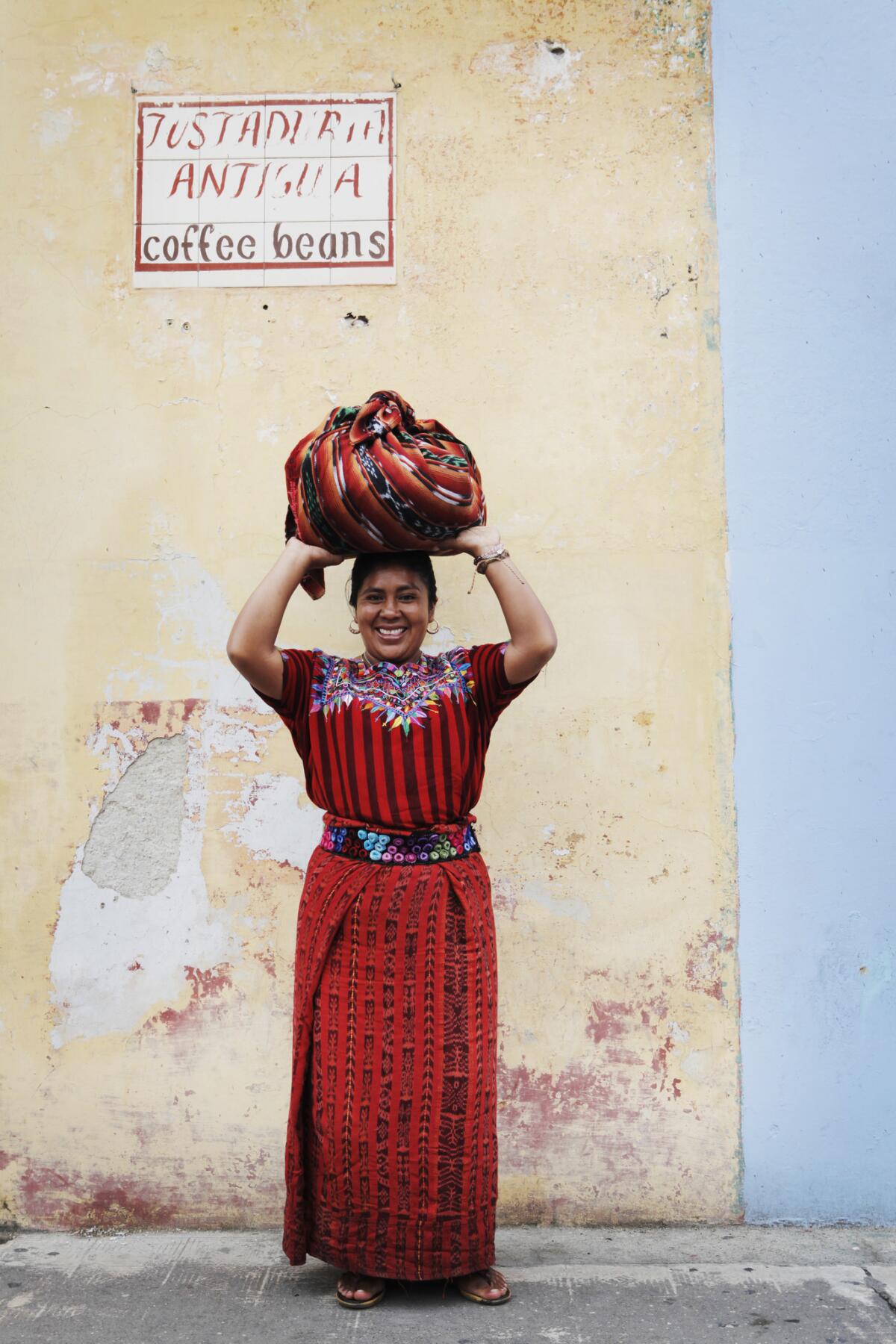On a trip to Guatemala with my toddler, her grandparents’ fears give way to fun

- Share via
Reporting from Antigua, Guatemala — When I told my parents I was bringing my 3-year-old daughter with me on assignment to Guatemala City, I heard a gasp.
“What? Are you crazy?” my mother said over the phone.
She turned her attention to my father, who was listening in. “She’s taking Cora to Guatemala. Can you believe it?”
“She’s crazy,” my father said.
The water was bad, they said. There’s crime, they told me. What would I do if Cora fell ill? Got kidnapped? What if she contracted a parasite?
The list went on and on.
I was taken aback. This was coming from parents who were born and raised in Guatemala.
Never mind that they regularly took my siblings and me to Guatemala on vacation throughout the 1980s and early ’90s — during the throes of a bloody civil war.
Some of my best childhood memories were formed in Guatemala, where I was allowed to roam freely, surrounded by extended family and friends. I wanted my daughter to experience the same.

I had half-expected them to pepper me with recommendations on whom to visit and where to go. Before calling them, I had prepared myself to temper their expectations. The worst-case scenario I had envisioned was persuading my father that we couldn’t possibly visit all his family in Jalapa, about a three-hour drive from Guatemala City, during our week’s stay.
You’d think that, at 39, I could muster enough courage to shrug off their concerns, but no. And my worries began to grow.
My husband and my sister reassured me. As it turned out, Cora was more than fine. My daughter had the best time of her young life.
We mostly stayed with the Ramirez-Moino family — my life-long friends with whom I spent most summers when I visited Guatemala. They doted on Cora, happily hauling her around the city while I was working.
Dunia, Guisela, Isabella, Carolina and Agatha, all women, took turns caring for Cora and became the small village I needed, a luxury I don’t have in the U.S.
I worried a bit about how to keep Cora entertained, but I quickly learned that in Guatemala — as in most of Latin America — life revolves around children. There really isn’t a place they can’t be taken and fawned over.
Into Antigua
When we weren’t at the Ramirez-Moino family home in Guatemala City, we spent time in the old capital of Antigua. Some of my fondest memories as a child were spent in the beautiful colonial town.
Some of the city has changed since I visited those many summers as a child, but it’s still a gorgeous getaway. You can catch a clear view of the Volcán de Agua (Volcano of Water) from any street in Antigua during most mornings. The city is friendly, safe and walkable.
Plaza Central is the heart of Antigua, a town square that serves as a gathering place dotted with benches, lined with trees and buzzing with vendors. Most days you’ll find large families with children playing around a charming fountain featuring four identical mermaids spraying streams of water from their breasts.
Some of my fondest memories as a child were running around that plaza, sucking on popsicles and guzzling atole, a hot maize drink. I would beg my parents to buy me the handmade wooden toys and cheap jewelry that vendors, dressed in rainbow-hued traditional garb from the region, where hawking.
The old women who peddled their street food have long been shooed away from the plaza, but those selling trinkets remain. They pushed the same toys and jewelry I once desired. Cora begged me for a carved wooden flute and a metal necklace decorated with a pink heart-shaped stone. I gave in.
We stayed at the Porta Hotel in Antigua, perhaps the most child-centric hotel in town. It touts a pristine pool with a shallow area for toddlers and even a kids club with regularly scheduled activities during the weekends.

The elaborate playground was closed for renovation while we were there in mid-September, but no matter; when my bébé wasn’t splashing in the pool, we hit the streets.
Antigua is best explored on foot. Strollers have a tough time handling the town’s uneven streets, so we left it at home. Cora was more than happy to take my hand and hoof it. (If you have babes in arms, wear a carrier.)
She gleefully allowed me to show her the city. I introduced her to the open-air markets and the artisan candied figs and canillitas de leche (candy made from condensed milk) from Dulces Doña María Gordillo, the same ones that made my mouth water as a child.
We were in Antigua on Sept. 15, Guatemala’s Independence Day, when the city is vibrant with decorations and musicians. At one point, Cora tried to join a passing school marching band and color guard, much to the delight of a nearby group of giggling school girls.
Our first stop was chocolate, of course. Guatemala claims to be the birthplace of chocolate. The Maya revered it so much they called it the “food of the gods.”
We went to one of the two ChocoMuseo locations in Antigua, a chocolate museum where we participated in a mini-workshop in which we crafted chocolate treats straight from the bean.

Alma, our teacher, took Cora to see a cacao pod growing on a plant. She opened it to expose the beans, which are dried and roasted.
“Really? Chocolate comes from there?” Cora asked.
We started with a freshly roasted batch of beans, separating the hulls from the interior nibs by hand, before grinding them with a pestle into a smooth paste. That was the bébé’s favorite part. At one point, she couldn’t help herself and shoved some in her mouth.
“This isn’t chocolate!” she said with disgust. “It’s sour!”
Alma and I laughed.
“You add sugar to make it sweet,” Alma explained patiently.
After class, we had freshly made chocolate that we had planned on taking home and sharing with friends. We quickly thought better of it, devouring it within minutes.
On the resulting sugar high, we traversed Antigua’s cobblestone streets, exploring small shops where Cora found a pair of must-have shoes decorated with rainbow-colored Guatemalan textiles. She ran around the park and made friends with local kids at a fountain near the yellow-hued La Merced, a Baroque church.
Later that evening, fireworks celebrated the country’s independence. The popping sounds took me back to August 1983. I was about Cora’s age and visiting Guatemala City. We were in the middle of running errands with my family near the National Palace when gunshots rang out. My mother rushed me and my sister to a nearby store where we ducked for cover.

Years later, I would discover that the gunshots were a result of a military coup that deposed then-President José Efraín Ríos Montt, Guatemala’s most notorious dictator.
During the week of our September visit, thousands of indigenous Guatemalans blocked sections of the a major highway, kicking off a week of marches, blockades and rallies to protest the current Guatemalan government’s decision to shut an international anti-corruption commission, which is now slated to shut down this September.
Since my visit, the country has faced numerous corruption probes but appears to have relatively calmed gearing up toward its general elections in June.
For a moment during my visit, I half wondered what I would do if we got caught in the unrest. We didn’t.
Instead, Cora experienced the same freedom I enjoyed when I visited Guatemala as a child. I grew up in the San Fernando Valley and led mostly a sheltered suburban life. My parents rarely allowed me to wander beyond the confines of my front yard.
In Guatemala, they allowed me to roam and explore, especially in Antigua. Cora chased the pigeons at the plaza, just as I once did. She danced to marimba music, just as I did. She scaled the trees and splashed the water in the fountains, as I had.
At one point, she marveled at a woman in traditional Guatemalan garb balancing a large stack of pink and orange roses on top of her head, hauling them to market.
“Whoa,” Cora said. “I want to do that. How does she do that?”
When we returned, my parents were ecstatic to hear the trip had gone well. Next time, they said, they’d like to join us.

If you go
THE BEST WAY TO GUATEMALA CITY
From LAX, Avianca and Delta offer nonstop service to Guatemala City, and Avianca, United, American, Aeromexico and Copa offere connecting service (change of planes). Restricted round-trip airfare from $503, including taxes and fees.
For the hour drive from the airport to Antigua, taxis charge anywhere from $30 to $40 for one to two people.
TELEPHONES
To call the numbers below from the U.S., dial 011 (the international dialing code), 502 (the country code for Guatemala) and the local eight-digit number
WHERE TO STAY
Porta Hotel Antigua, 1 8th Calle Poniente, Antigua, Guatemala; 7931-0600. Spotless, child-friendly and centrally located with pool. Deluxe rooms $165, including breakfast.
El Convento Boutique Hotel, 11 2nd Avenida Norte, Antigua, Guatemala; 7720-7272. Luxurious, family-friendly hotel with small pool. Standard room with two double beds from $194, including breakfast.
Hotel Cirilo, 11 Calle de los Duelos, Antigua, Guatemala; 7832-6650. Elegant boutique hotel, family-friendly with helpful staff and comfy beds. From $145, including breakfast.
Yellow House, 24 1st Calle Poniente, Antigua, Guatemala; 7882-4699. Clean, centrally located hostel. Doubles $30, including breakfast.
WHERE TO EAT
El Refectorio (Restaurante Casa Santo Domingo), 28A 3rd Calle Oriente, Antigua, Guatemala; 7820-1220. International as well as typical Guatemalan food offering breakfast, lunch and dinner. Meals about $13.
El Convento,11 2nd Avenida Norte, Antigua, Guatemala; 7720-7272. Traditional Guatemalan dishes shine at this elegant eatery. Good selection of wine. Open for breakfast, lunch and dinner.
La Toscana, No. 17A 1a Avenida Sur, Antigua, Guatemala; 7832-9864. This Italian eatery features delicious house-made pastas, pizza and Mediterranean food. Open for lunch and dinner. Pastas from $9.
WHAT TO DO
ChocoMuseo, two locations in Antigua; 7832-0219. Several chocolate-making classes are offered at various prices. Available in English and Spanish Also, there is a chocolate museum one can enjoy for free. We took the 45-minute “mini chocolate workshop” geared for children ($13 per person).
ds will love wandering around the gardens checking out the animals, such as chickens, ducks, lambs and goats. The farm-to-table restaurant is especially good. Closed Mondays.
TO LEARN MORE
Follow Cindy Carcamo on Twitter @thecindycarcamo
More to Read
Sign up for The Wild
We’ll help you find the best places to hike, bike and run, as well as the perfect silent spots for meditation and yoga.
You may occasionally receive promotional content from the Los Angeles Times.







